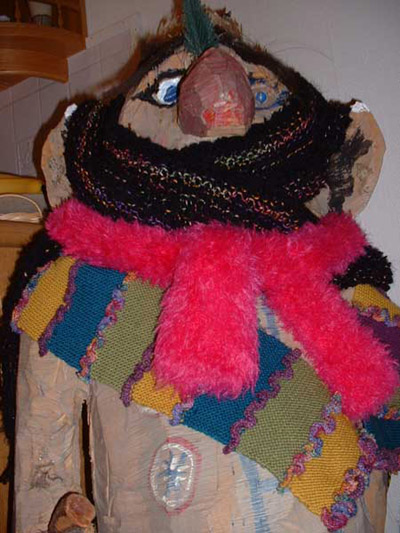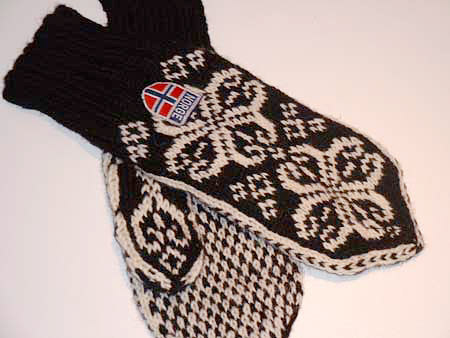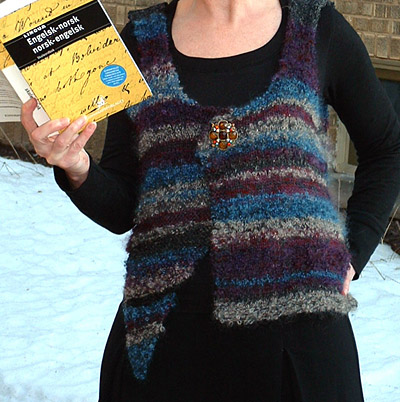  "Just
forget
about the ice!" is the punch line to
a story a fellow American in Norway liked
to tell about power-walking (in the dark,
I might add) with a group of Norwegian women
along the treacherously ice-rutted streets
of Kristiansand. To understand the joke is
to understand something about the Norwegian
attitude towards just about any endeavor.
For me, this attitude came to teach me a great
deal about knitting. "Just
forget
about the ice!" is the punch line to
a story a fellow American in Norway liked
to tell about power-walking (in the dark,
I might add) with a group of Norwegian women
along the treacherously ice-rutted streets
of Kristiansand. To understand the joke is
to understand something about the Norwegian
attitude towards just about any endeavor.
For me, this attitude came to teach me a great
deal about knitting.
For the 12 months I lived
in Norway, I traveled extensively with my
husband to large towns, remote fishing villages
and exotic outposts throughout the country.
We ventured far beyond the Arctic Circle
encountering Polar bears, seals, reindeer
and moose and, always, no matter how isolated
or remote, one could find yarn and knitting
supplies side by side with other basic needs
at the local grocery or hardware store.
Here, where children seem to emerge from
the womb with knitting needles in hand,
knitting is not a craft for otherwise idle
hands. It is a practical necessity for a
rugged life where many hours of each day
are spent outdoors.
While I was giddily surprised
by the abundance of knitting yarns and supplies
at my disposal, the extent and diversity
of traditional Norwegian patterns for mittens,
gloves, socks and sweaters was beyond anything
I had imagined when living in the States.
While pattern charts needed no translation,
the written pattern directions did. My desire
to be able to translate directions from
Norwegian to English became one of the strongest
motivators for my learning the language.
(Well, that and being able to order our
meat and fish from the local grocer, but
that's another story.)
  Knitting
books and magazines have been my dependable
guides to learning the craft of knitting
since I began four years ago. Cables, sock
heels, intarsia, fair isle, even twined
knitting -- it seemed I could successfully
teach myself everything I needed to know
as long as I was armed with well-written
and illustrated instructions. Knitting
books and magazines have been my dependable
guides to learning the craft of knitting
since I began four years ago. Cables, sock
heels, intarsia, fair isle, even twined
knitting -- it seemed I could successfully
teach myself everything I needed to know
as long as I was armed with well-written
and illustrated instructions.
Accustomed as I was to
reading patterns written in the U.S., Norwegian
patterns seemed to be missing directions.
At first I blamed my novice language skills
and spent what seemed like hours writing
out word-for-word translations. But, no.
There WAS something missing in these patterns.
A hat pattern instructed
me to decrease for the crown until X number
of stitches remained. The number of stitches
to decrease per round remained a mystery.
Should I decrease every round? Every other
round? The directions were mute on these
details.
A sweater pattern was
a bit more helpful in providing the numbers
for increases and decreases, but lacked
any direction for the best method of adding
or subtracting stitches. SSK? Slip stitch,
knit 1, pass slipped stitch over? Or, simply
knit two together?
Then, there was the pillow
pattern that gave no hint as to whether
it should be assembled before or after knitting
the all-around border.
After hearing my friend's
"forget-about-the-ice" story, it occurred
to me to view these curious pattern omissions
in a larger context. After all, Norwegian
culture is nothing if not grounded in the
concept of common sense. My American friend
was not being admonished to conquer her
fear of falling on the ice by pretending,
in some Zen-like manner, that the ice was
not there. No, not at all.
Instead, she was experiencing
a typical Norwegian reaction to having the
obvious pointed out to them. "Yes, there
is ice," they might just as well have said,
"and if you're not prepared to walk over
it, why are you here?"
It's an attitude that's
demonstrated in their knitting patterns,
too. "Yes, you obviously have to increase
your stitches, and if you can't figure out
the best way to do so, why are you knitting
this garment?"
Fair enough.
With a bit of analysis,
common-sense logic and a hearty dose of
trusting what little knitting intuition
I had acquired in four short years, I learned
to fill in the blanks on my own with these
Norwegian patterns -- and my knitting has
been forever changed as a result.
  Oh,
I still follow pattern directions, but not
slavishly. If my gut feelings tell me that
something just looks wrong, or if a pattern
direction sounds wrong, I'm no longer afraid
to abandon ship or take charge of my knitting
by making changes that vary from the pattern
as written. Oh,
I still follow pattern directions, but not
slavishly. If my gut feelings tell me that
something just looks wrong, or if a pattern
direction sounds wrong, I'm no longer afraid
to abandon ship or take charge of my knitting
by making changes that vary from the pattern
as written.
I pay closer attention
to my yarn and try to determine what it
is that the fibers wish to do naturally.
How much elasticity does the yarn have?
How can I work a particular yarn to its
best advantage?
And, I pay close attention
to the most obvious element for any knitted
object -- the numbers in my gauge swatch.
Recently, I knit my very
first garment without any pattern at all
-- an asymmetrically shaped vest, knit from
a variety of yarns in my stash. It felt
a bit like speed-walking on a dark, icy
street in Norway.
Exhilarating.
|

